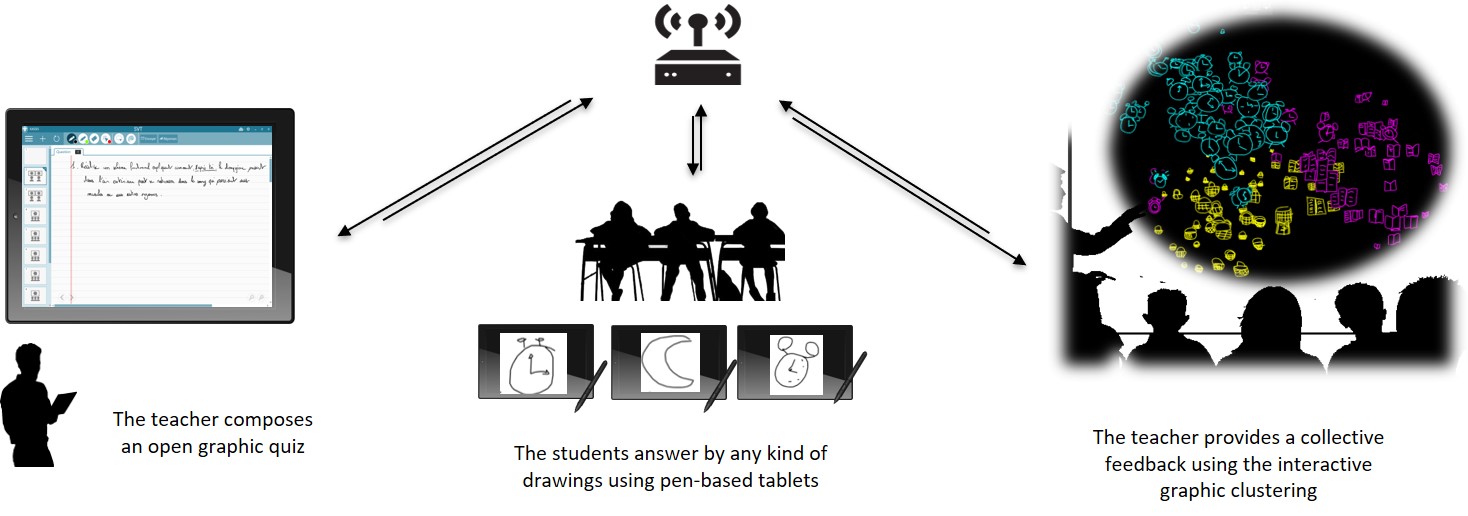2.1 Objective 1: Consolidate and improve the KASSIS solution
The KASSIS solution is based on the networking (autonomous network or existing network) of a set of pen-based hybrid tablets. It is an interactive digital notebook solution based on several innovative concepts that are integrated within the same digital learning environment. It offers:
- Students and lecturers direct handwritten note taking on the slides to facilitate the composition of formulae, diagrams, sketches, drawings, and annotations (going beyond limited keyboard input);
- Handwritten enriched graphic quizz composition for teachers: The questions can be expressed on the fly, by sketching or drawing directly on the tablet display (going beyond rigid and planned interaction-based quizzes or push buttons);
- Realtime aggregation and analysis of collected responses for immediate feedback for students and teachers.
The aim of Study 1 was to analyze note-taking habits and the acceptability of note taking and drawing on a pen-based tablet, as well as to identify students’ needs. In recent years, taking notes on a computer rather than in longhand has become extremely common during lectures, but this general observation masks considerable disparities between disciplines. Results of a survey conducted among 323 students in computer science and social sciences showed that 1) tablets with pens are actually used by students to a very limited extent (0.62% of students), 2) computers are used more than paper in social sciences for note taking (about 60% use computers and 36% use paper), but 3) computer science students have specific problems writing or drawing formulae, diagrams, sketches on computers (94% use paper and the remaining 6% use computers). In conclusion, using a tablet with a pen may be particularly relevant for disciplines in which sketches or formulae are frequently used.
As a result of other UCD studies (see Objective 2), the eFIL project consolidated the KASSIS solution and added two new functionalities to improve the automatic synthesis of the collective feedback. Depending on the type of hand-drawn student response, the new version of KASSIS can now provide one of two types of collective visual feedback:
- An interactive saliency map (heatmap): Based on a reference document (e.g. diagram, sketch, picture), the teacher can ask learners to select, emphasize or complete part of a document by hand drawing. All these hand-drawn responses are then aggregated in the form of a visual heatmap displayed to both teacher and students. The teacher can then validate the correct response, so that it can be shown to the whole class;

- An interactive graphic clustering: we have designed an automated generic clustering of handwritten graphics (Symbols, Mathematical equations, Drawings…) based on the fuzzy C-Means approach with a dedicated feature selection using HBF49 features and t-SNE algorithm. This clustering has been developed and tested on the large Google “QuickDraw” dataset.
Teachers can give learners open graphic quizzes to do, eliciting responses in the form of drawings (e.g. mathematical formulae, sketches, symbols). KASSIS provides the teacher with a clustered view of the graphic responses, where similar graphic answers are gathered together. KASSIS can display either a flat view of the graphic clustering or an interactive 3D view.

